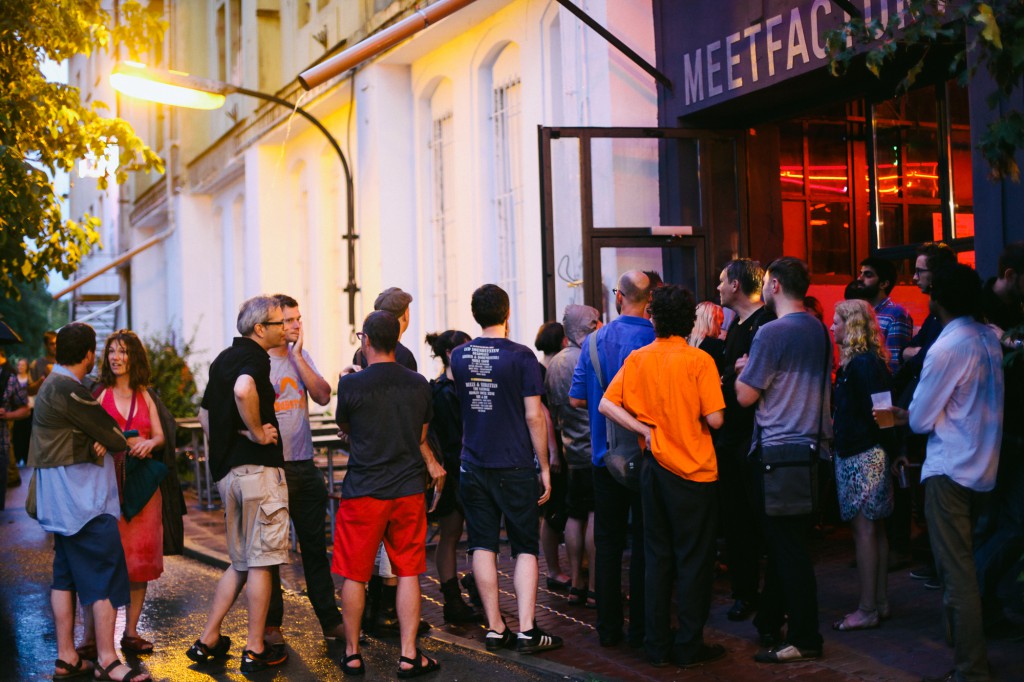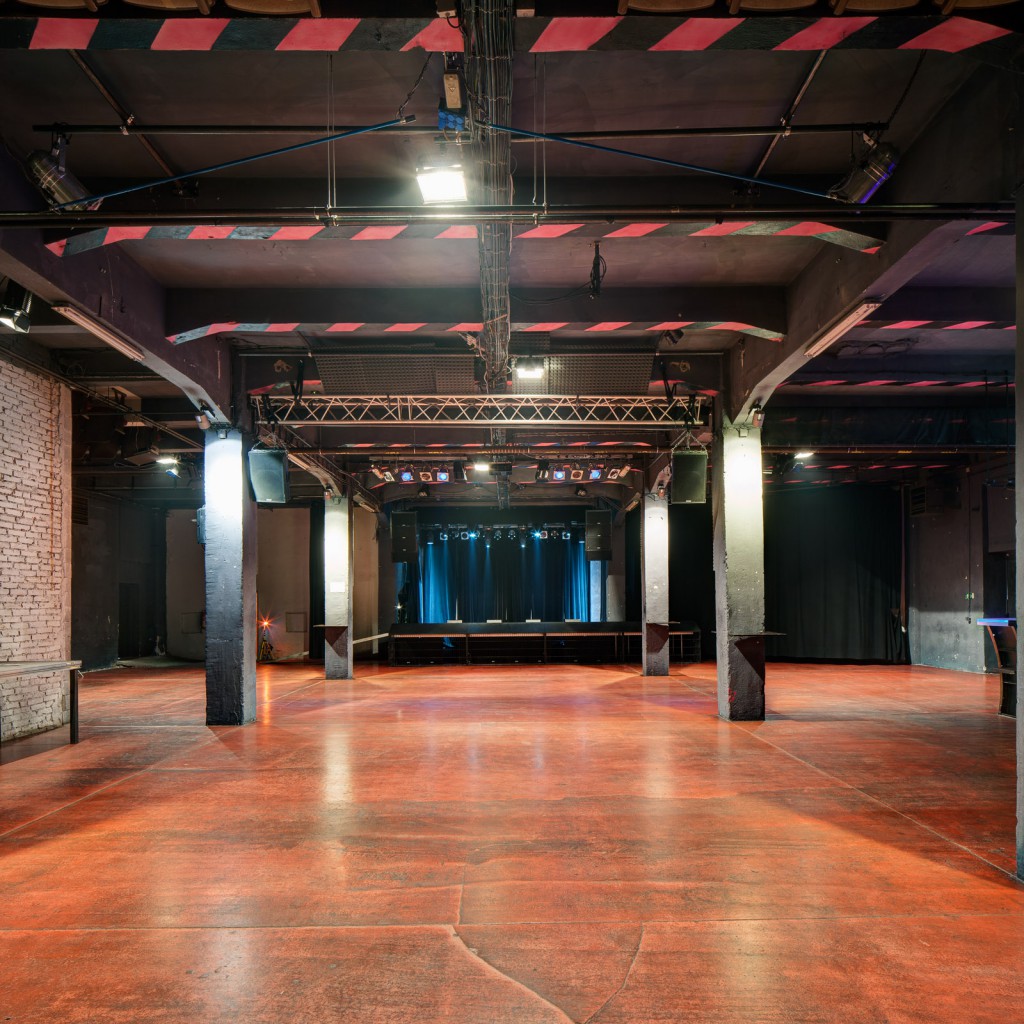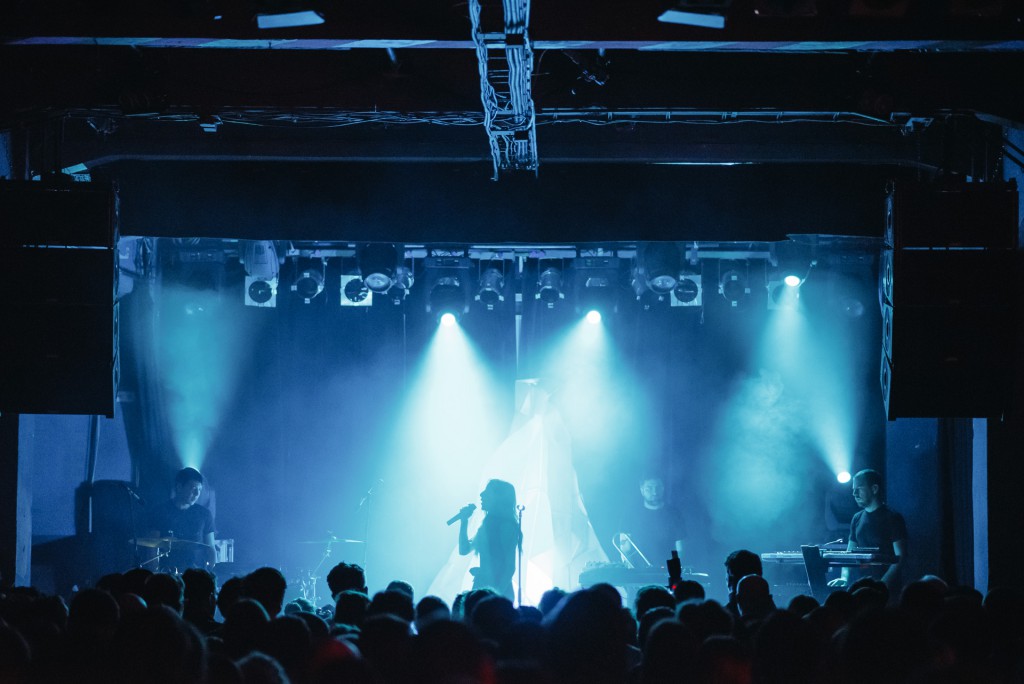MeetFactory is an arts space in Prague’s post-industrial area of Smíchov. Nestled between train tracks on one side and a busy road from the other, the sprawling warehouse is a modern multidisciplinary cultural hotspot, hosting music events, theatre performances, exhibitions. Michal Brenner, who is also one of SHAPE’s coordinators, is responsible for MeetFactory’s music programming.
We are sitting at the MeetFactory in its Theatre Hall at the moment. Can you describe the venue and its various parts?
Michal Brenner: It was founded in 2001 by Czech sculptor David Černý, originally in a different location which was flooded only a year after it started. After three years of looking for a new location, they found this one. This is a former glass factory warehouse, actually. The building is owned by the city which let us use it for 1 Czech crown per year, but we have to take care of it. MeetFactory invested heavily into what was formerly a completely abandoned building and a squat and turned it into what it is now – the biggest artist-in-residence venue in the Czech Republic. We have three gallery spaces, a theatre and a 1,000-person capacity music hall. This was developed gradually from 2007 to 2010 when the music hall opened, which I take care of. It’s a three floor building in an industrial area of Prague. We do around 300 public events a year.
What kind of concept do you have in terms of music direction?
MB: It reflects what I did before MeetFactory. I had a festival called Sperm which was part of the ICAS network (International Cities of Advanced Sound) and largely focused on electronic and experimental music. Gradually I started promoting other bands too, more in the vein of indie or psychedelic rock. MeetFactory reflects both of these directions – we do have indie pop or rock concerts, as well as electronic bands, we do alternative hip hop. Bearing in mind that we have a 1,000-person capacity hall, we can’t really do small shows. We do the kinds of Gus Gus, Caribou or Animal Collective.
How is the local Czech scene reflected in the booking of MeetFactory?
MB: We don’t really book Czech bands or artists as headline shows, there is already quite a saturated market for that. We tend to bring foreign artists or bands more that have had little exposure so far. In terms of local artists, that is also what we have done from the start – also during the Sperm festival, ie give young and emerging artists a chance to play at a bigger venue than they are normally used to. Some of these bands are now mature and have become well known in the Czech Republic. We give this back to the scene and try to kickstart it this way.
Over the years of your work here, have you observed a development in terms of the effect that the space has had on the local scene and the audience?
MB: We are a sort of inspiration for other venues and promoters. There is a festival called Lunchmeat that started few years after the Sperm Festival and now continues what we were doing at that time, there is a festival called Elekce, which is done by really young people who only book Czech artists, and the festival actually takes place at MeetFactory. It’s hard to measure if the scene has grown over the past five or six years but I think we definitely helped educate the audience and do many events and make people meet and start collaborations.
What is the most important aspect of your work here?
MB: It has several aspects. We have to fill the venue because it’s a pity just to leave it empty, so we try to programme around 90 events per year. The majority of the artists can be considered emerging. We try to educate the local scene by bringing artists that they wouldn’t normally have exposure to and give opportunity to young bands to play in contexts they are not used to. Of course, everything has to be financially viable. We have support from the city council but it’s still not an easy task to make ends meet. I have to balance everything. I’m not doing as much experimental stuff as I would like to because it’s really financially difficult to do this.
You are the main coordinating body of the SHAPE project. How did MeetFactory get involved in SHAPE?
MB: It started in the days of the Sperm Festival, which happened from 2006 to 2011. We were part of the ICAS network and had meetings with the other festivals such as CTM, Unsound or Skaņu Mežs. We had similar set of problems and shared ideas and solutions. The idea arose at one of the meetings last year when we talked with Viestarts Gailitis, the director of Skaņu Mežs Festival, about an opportunity for funding and we proposed to our partners this platform called SHAPE to do what we’ve been doing all these years – help emerging artists. We set up a project around the mobility of artists, their promotion and education.
Each SHAPE institution nominates three artists per year into the pool of 48. Can you say something about MeetFactory’s choices for 2015?
MB: Michal Šeba is a very universal artist. Originally a photographer who also works with music and sound. He used to be in several bands in the 90s and early 2000s. He developed a very interesting project called ACUO, which takes real time field recordings and transforms them into a sound installation. It also creates an environment where silent concerts could happen, which people listen to via their headphones or radios. It’s a unique project which happens in public space, so people could stop by and listen. There are sound artists and installations in Prague or the Czech Republic but for me they tend to work in a rigid way, whereas Michal’s approach, coming from other fields like photography and visual arts, is very unique and that is why I chose him.
Another musician is Stanislav Abrahám, a very humble guy. His approach to music and sound is unique and he hasn’t had much exposure so far. He creates sonic landscapes and works with stereo and programmes his own patches.
The third artist is Pavel Karafiát, who doesn’t have an art background at all, but a technical one – programming, IT. Pavel creates real-time rendered visuals. I like when art is approached from somewhere else, which is the case in Pavel’s work. He doesn’t consider himself an artist really. He has created many visuals and installations in collaboration with other artists but I think it is his input that makes them unique.
What SHAPE events are planned by MeetFactory in 2015?
MB: Most of the SHAPE partners are actually festivals except for a few such as Arcadi Némo, which is a biennale mostly working with visual art. MeetFactory doesn’t have a festival, so we had to find a way how to present the SHAPE artists. We have events called Public House, where we join forces with the other departments of MeetFactory meaning visual arts, theatre, artist-in-residence, and music. We open each of these for the public for a free entrance fee, and this was the natural platform for presenting SHAPE artists. We have four of these events this year and we chose the first three of them for SHAPE – April, June and September. At each one we will present three SHAPE artists. Two of them would be performing and one would be an installation or the artist would come for a residency. The first one will happen on Thursday, April 9th with Mondkopf, RSS B0YS, Stanislav Abrahám and we will also have an installation by Joris Strijbos, so we actually have four this time.
How do you see SHAPE’s future and legacy?
MB: When we were first thinking about SHAPE, the aim was to create a brand. Even though it’s a word from the commercial world, it works. By creating a functioning brand we would be able to promote artists beyond what’s supported by the EU. If we have the tools and partners and visuals, we will be able to help artists in ways that we wouldn’t be otherwise. It’s the same way as labels work. If you have a label that’s a good brand, such as Warp Records, you can take on an emerging artist and it helps them to get known better by international audiences and be taken differently by journalists. That’s what we are trying to aim for with SHAPE, that after three years, if you say “SHAPE” to a musician or a journalist, they would know what it is and consider it a seal of quality. I’m confident that with the 16 partners we have, we will be able to do this. The curators of these festivals are actually the quality assurance of this project.
Will the project also be open to applications from the musicians themselves?
MB: We are still thinking about it. It’s a double-edged sword, there are pros and contras. The obvious pro is that even though we are 16 curators, we don’t know everyone and there could be someone we might have missed. On the other hand, it creates so much administrative work and it would prolong the process of selecting the artists.
And in terms of MeetFactory, what has the future in store for this multidisciplinary art space?
MB: There is hopefully a bright future for MeetFactory. We’ve got our contract for the building renewed for ten years, and this happened for the first time. We have thus more time to develop things, apply for extra funding, which was impossible when we only had a five year lease. We also got approved funding for the next four years starting in 2016, which is a bit bigger than before. And we can start progressing into what we haven’t done so far, which is the more experimental type of events and smaller concerts. This doesn’t involve music only because we have to split the funding with the other departments. Generally it means more stability, so we can experiment more and do new stuff without having to be so dependent on money.


